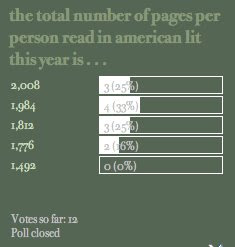 Busted.
Busted.But for what, I'm not exactly sure; I suppose technically this isn't a note. On principle, though, I think I've got something on you two . . .
prb.'s Online Classroom, where we get down with American Lit. (And plenty of other stuff, too.)
 War Games
War Games Lucille Clifton, author of "Homage to My Hips," the poem that we looked at in class a few weeks ago, will be featured at the University of Minnesota's NOMMO African American Authors Series this next Thursday, April 24 from 7:30-9:30pm at the Cowles Auditorium in the Hubert H. Humphrey Center. Cost is $10. Complimentary tickets available for U of M students and members of the Friends of the University of Minnesota Libraries. Order tickets through Northrop Ticket Office at www.tickets.umn.edu, by phone at 612.624.2345, or in person Monday-Friday, 10am-5pm at 105 Northrop Auditorium, 84 Church Street S.E., Mpls, 55455.
Lucille Clifton, author of "Homage to My Hips," the poem that we looked at in class a few weeks ago, will be featured at the University of Minnesota's NOMMO African American Authors Series this next Thursday, April 24 from 7:30-9:30pm at the Cowles Auditorium in the Hubert H. Humphrey Center. Cost is $10. Complimentary tickets available for U of M students and members of the Friends of the University of Minnesota Libraries. Order tickets through Northrop Ticket Office at www.tickets.umn.edu, by phone at 612.624.2345, or in person Monday-Friday, 10am-5pm at 105 Northrop Auditorium, 84 Church Street S.E., Mpls, 55455. The new documentary, Zora's Roots, will air on PBS stations beginning April 18. Paying tribute to the most prolific woman writer of the Harlem Renaissance, the film traces Hurston's life and work from her childhood in the all-black township of Eatonville, Florida, to her days as a Barnard student in New York City, to her anthropologic field work in Honduras and Haiti, and eventually back to Florida, where she died penniless and was buried in an unmarked grave.
The new documentary, Zora's Roots, will air on PBS stations beginning April 18. Paying tribute to the most prolific woman writer of the Harlem Renaissance, the film traces Hurston's life and work from her childhood in the all-black township of Eatonville, Florida, to her days as a Barnard student in New York City, to her anthropologic field work in Honduras and Haiti, and eventually back to Florida, where she died penniless and was buried in an unmarked grave.




